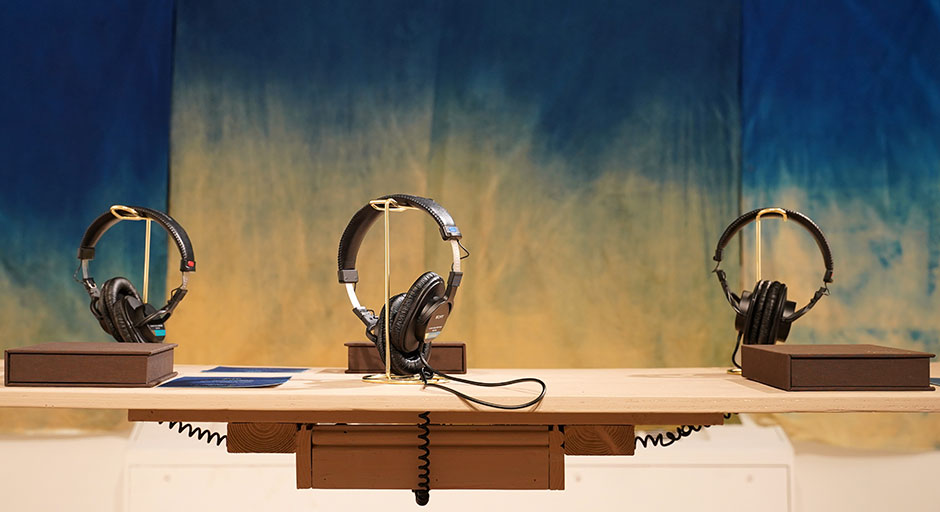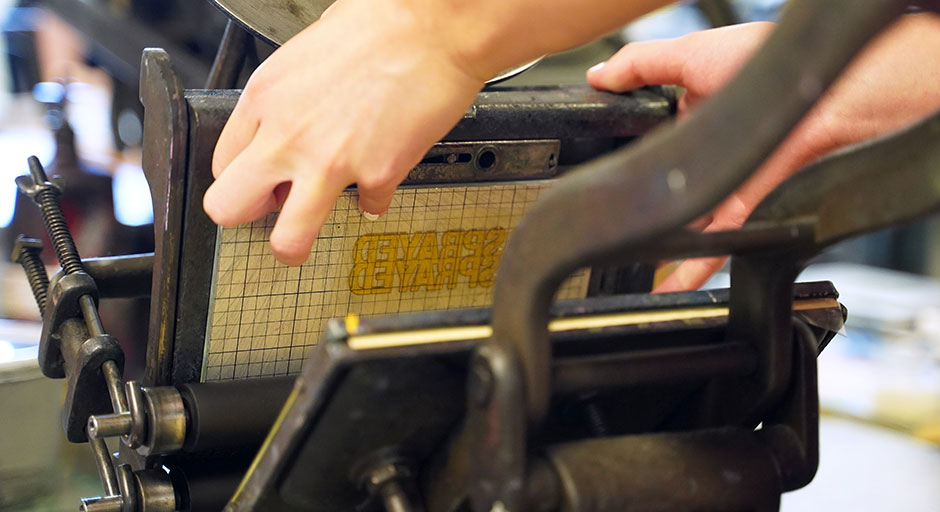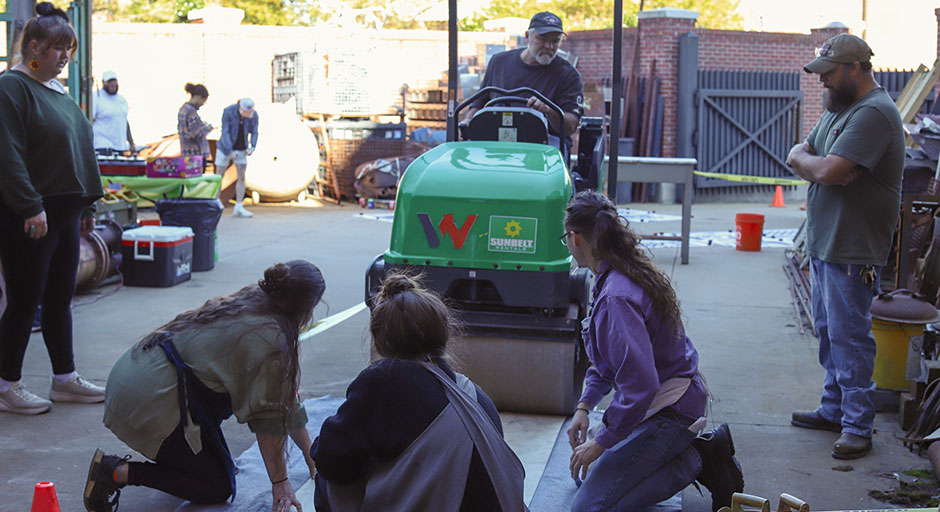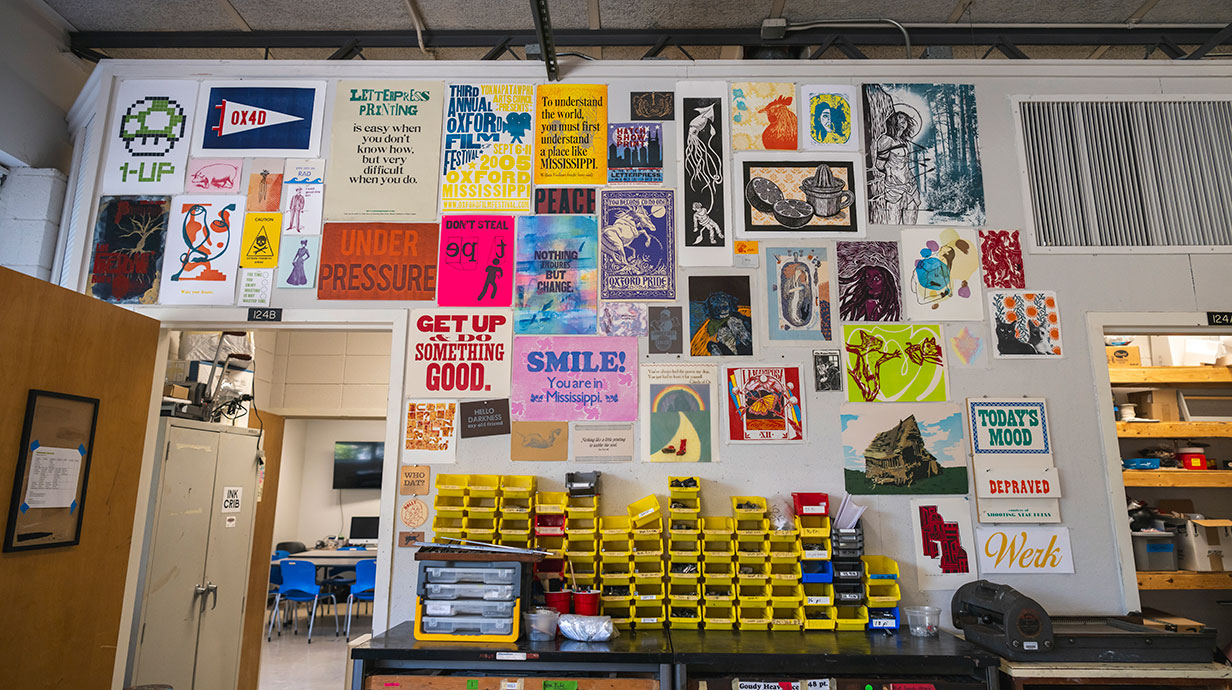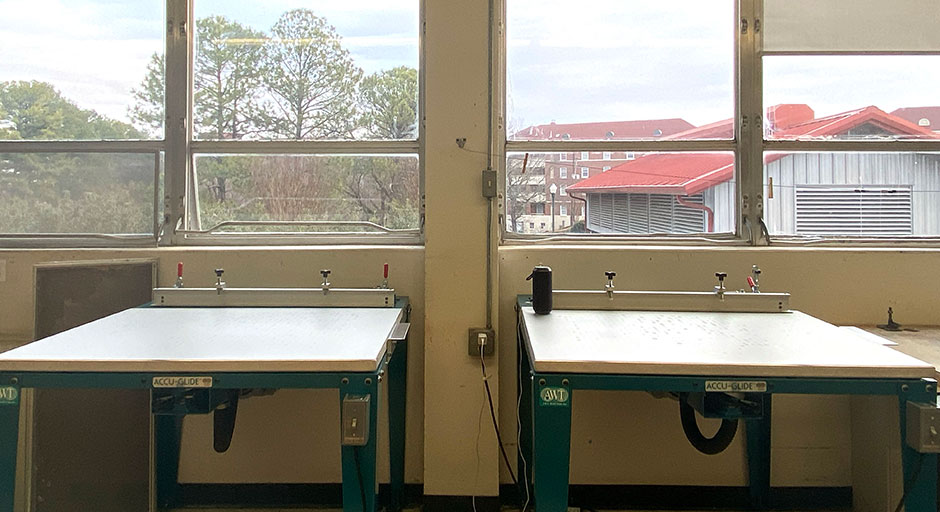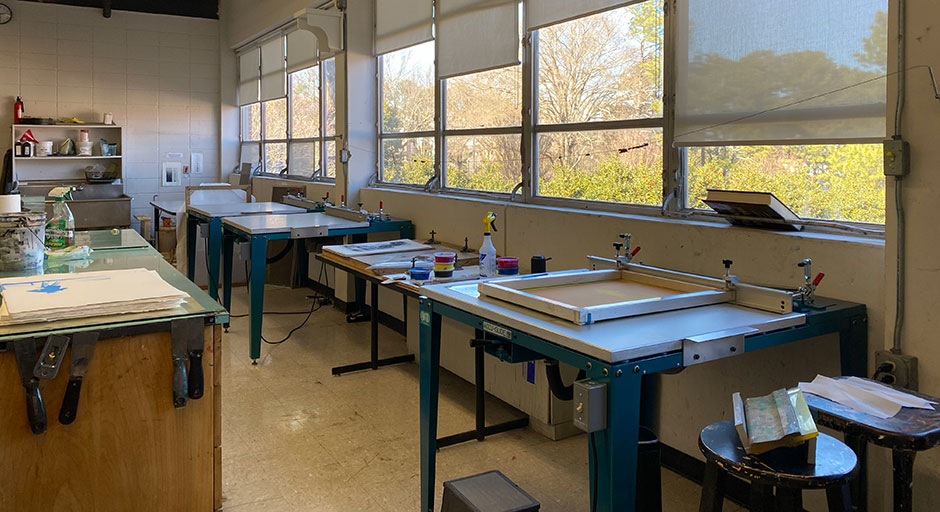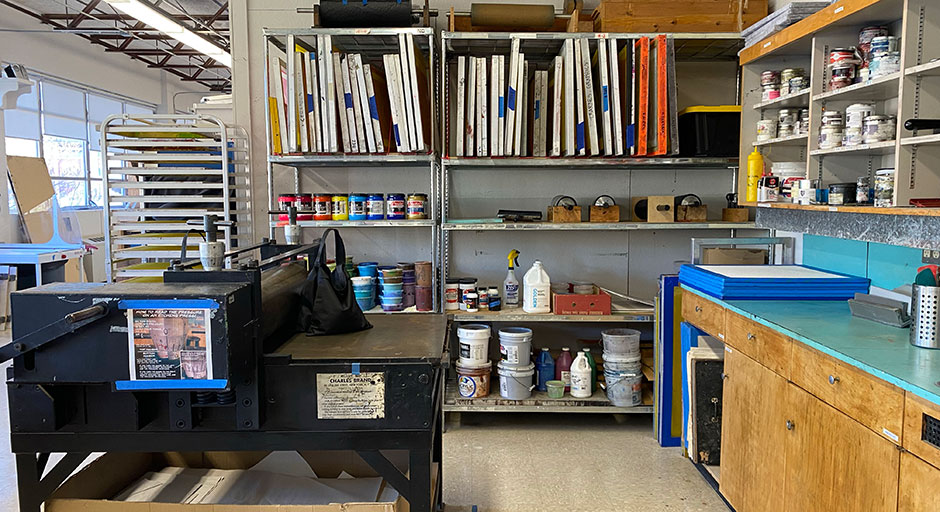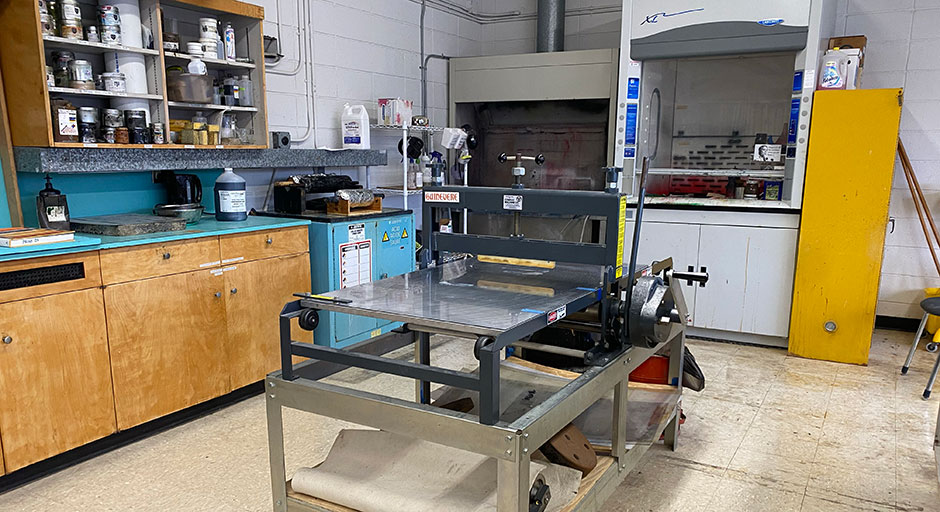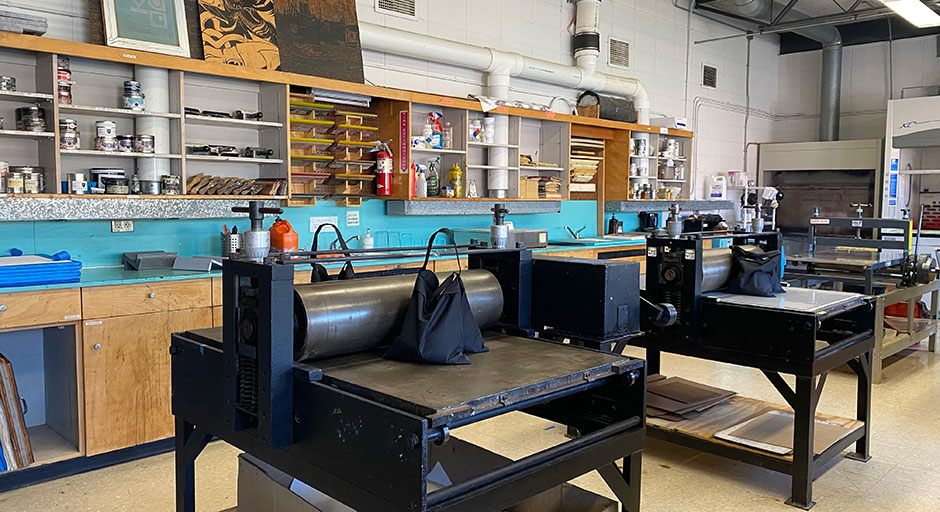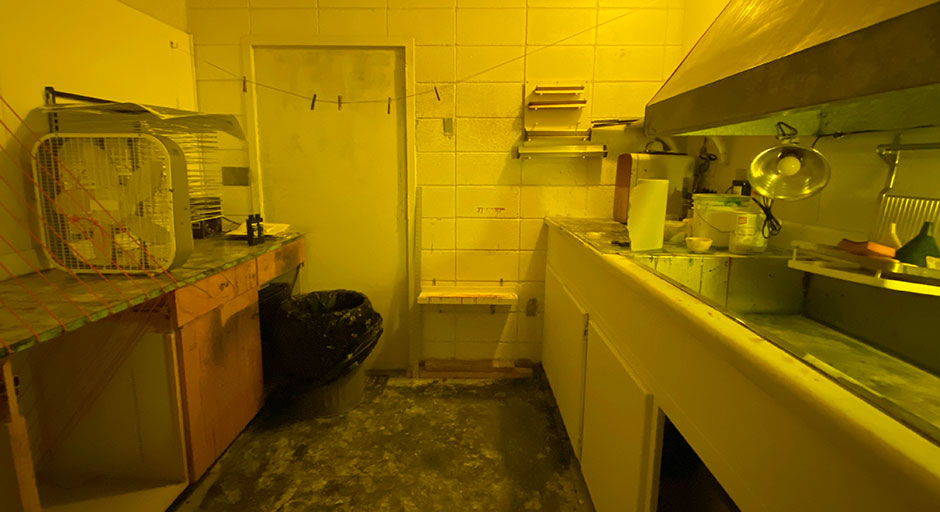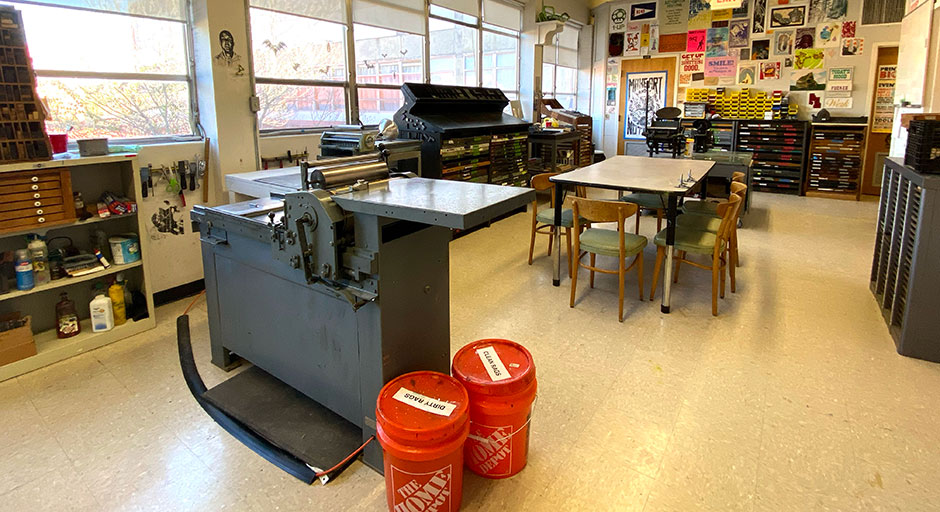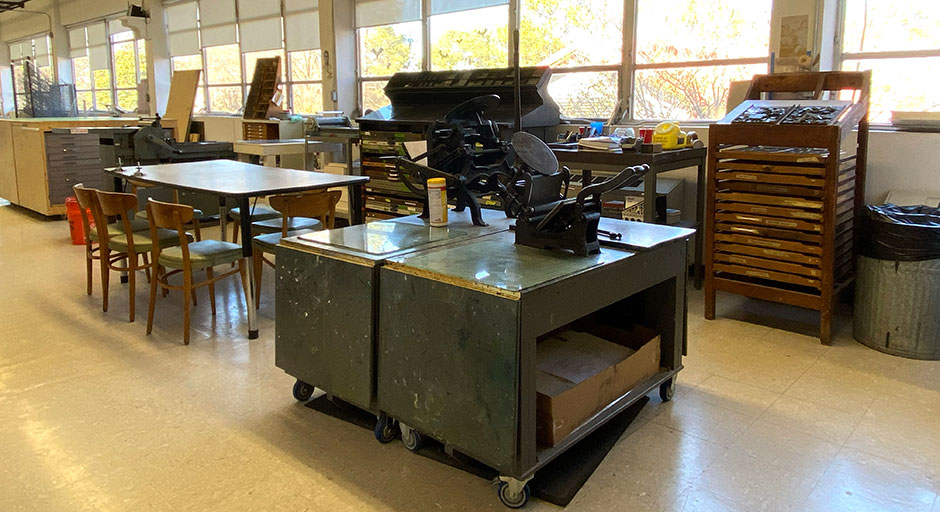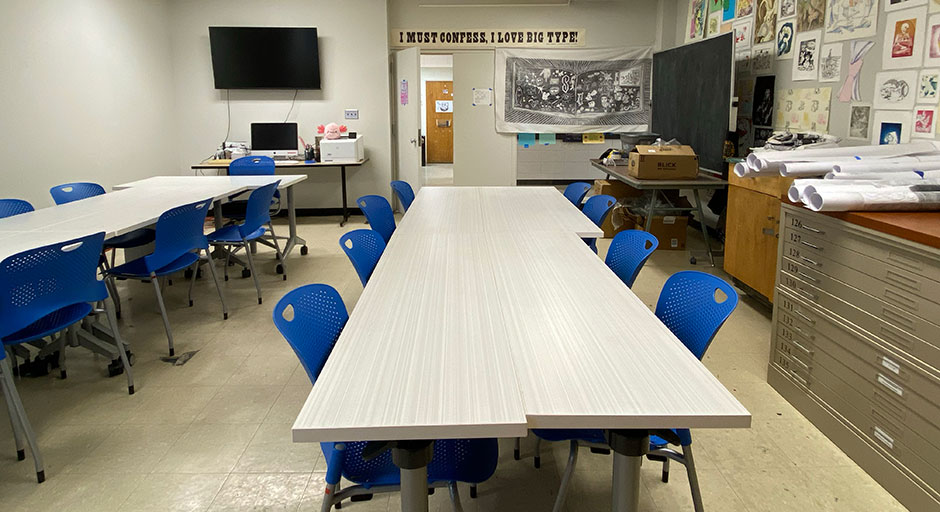Printmaking
A hands-on processes working directly with materials and techniques that connect to centuries of artistic tradition.
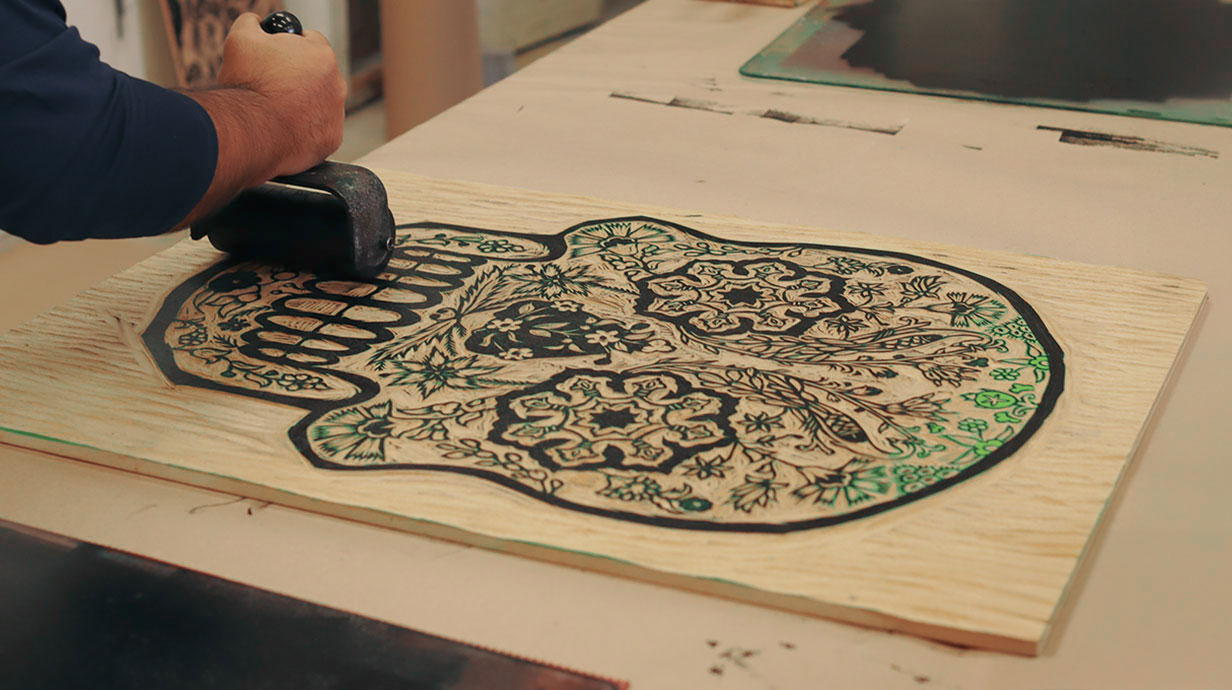
"I was drawn to Meek’s welcoming community and support for interdisciplinary art."
Angel Morgan
B.F.A. in Art (Printmaking)
Craft Images by Hand, One Impression at a Time
Printmaking is a process in which ink is transferred from a matrix (i.e. metal plates or limestone matrix, wood blocks, or screens) to material like paper, fabric, wood, or stone. The process is capable of producing multiples of the same piece, which is called a ‘print.’ Our studio teaches the traditional mediums of relief, intaglio, lithography, and silkscreen while also encouraging the use of photo processes, digital, and alternative methods. Printmaking offers students a unique intersection of media and a strong foundation that enables them to tackle formal, technical, and conceptual creative problems.
See More Printmaking On Flickr

Welcome From Our Studio Head
Hello, and welcome to the Printmaking Studio! My name is Kaleena Stasiak and I am the Area Head and Assistant Professor of Art, Printmaking at Ole Miss. I fell in love with print after my first Introduction to Printmaking class, and I know you will too. Printmakers share equipment and space, so there is always a lot of collaborative energy in the studio. Our space is well-equipped with traditional and digital printmaking processes so there is something for everyone. If you have any questions, feel free to reach out! Looking forward to sharing all things printed with you.
Kaleena Stasiak
Assistant Professor of Art Printmaking
Meet The Majors
See what currents students have to say about the department.
Featured Courses
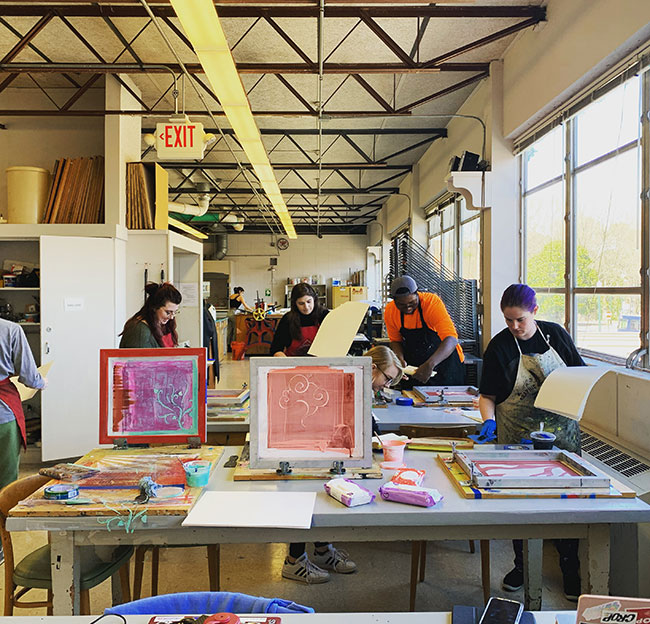
ART 371: Introduction to Printmaking
Introduction to historical and contemporary studio practice of printmaking; explore traditional techniques in intaglio, relief, screen process, lithography, and monotype.
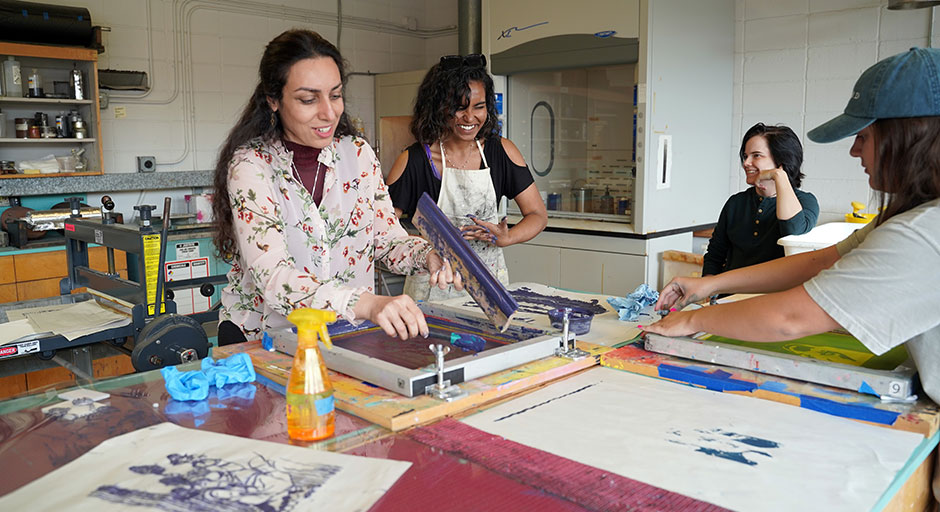
Art 372: Intermediate Printmaking
This course includes lectures, discussions, and demonstrations exploring traditional print processes with the incorporation of digital practices.
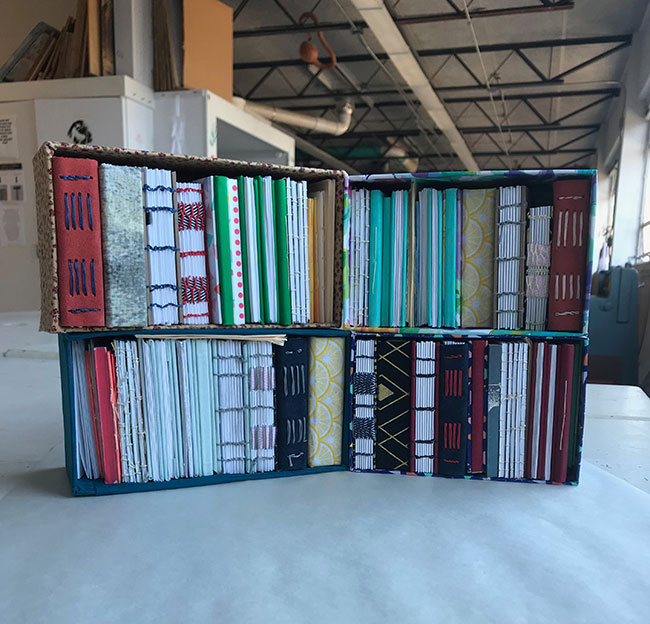
Art 373: Book Arts
Exploration of handmade books, including alternative bookbinding structures and successful integration of printed image and text.
Printmaking Studio Equipment
The studios are equipped with presses for etching, lithography, and screen printing, as well as tools for relief, intaglio, and monotype techniques. We also offer digital printers, large-format scanners, and a variety of papers, inks, and plates to support all your printmaking needs. With professional-grade equipment and ample workspace, the studio is designed to help you explore and create across multiple print media.
- 37” x 46” NuArc Mega-Light vacuum frame exposure unit
- 3 AWT Accu-Glide Vacuum Tables
- (2) 30” x 50” Charles Brand presses
- Ferric chloride vertical etching bath
- 18” x 24” hot plate
- Variety of Takach brayers
- Ventilation hood for spray paint or airbrush aquatint
- Metal shear
- 27” x 48” Conrad combination press
- Lithography stones in various sizes
- Levigators
- Graining sink
- Vandercook SP15 proofing press
- 6” x 9” Chandler & Price platen press
- 5” x 8” Kelsey Excelsior Model N platen press
- Line-O-Scribe Showcard proof press
- Dick Blick magnetic sign press
- Vandercook No. O proof press
- Collection of lead and wood type as well an assortment of ornaments
- 3 Boxcar bases (4 ½” x 7 ½”, 6” x 9”, 13” x 19”)
- Book press
- Triumph MBM 1110 paper cutter
- Guillotine
- Wire and plastic coil binding machines
- 3 IMacs
- 12” x 17” Scanner
- HP LaserJet Pro 3001 dw (black and white)
- HP Color LaserJet Pro M45dw (color)
- Canon Pro 2100 for large format printing
- SF9450 EIIU Risograph with 4 colors: Yellow, Flo Pink, Teal and Black
- Glowforge
Room 124 A – Studio
- Dimensions: 9’ x 13’
- 2 work desks
- 1 storage cabinet
Room 124 C – Studio
- Dimensions: 8’ x 9’
- 1 work desk
Room 124 D – Studio
- Dimensions: 8’ x 9’
- 2 work desks
Room 124 E – Studio
- Dimensions: 8’ x 9’
- 1 work desk
Room 124 B – Storage Room
- Dimensions: 9’ x 13’
- 3 metal flat files print storage
- 3 – 48” x 48” laminate covered worktops with wooden base cabinet and drawer storage on casters
- 2 – 25” x 96” laminate covered worktops with wooden base cabinet and drawer storage on casters
- 1 – 25” x 48” laminate covered worktops with wooden base cabinet and drawer storage on casters
- 1 – 24” x 72” mounted worktop counters with wooden base cabinet and drawer storage
- 2 – 24” x 76” mounted worktop counters with wooden base cabinet and drawer storage
- 1 – 24” x 56” mounted worktop counters with wooden base cabinet and drawer storage
- 5 above-ground wall mounted wooden storage cabinets with shelving
- 2 built-in wooden student storage cabinets with shelving
- 1 built-in wooden storage cabinets with shelving for inks and tools
- 1 built-in storage area above built-in wooden storage cabinets
- 1 single basin hand washing sink
- 1 wall mounted paper towel dispenser
- 1 chalkboard for instruction
- 1 sink
- 2 storage cabinets
- 1 darkroom spindle door
- 3 Box Fans
Other equipment include a vacuum frame exposure unit and a dark room equipped for silkscreen and alternative lithography and intaglio methods, such as photolithography and photopolymer intaglio. Also a hot plate, a book press, large paper cutter, mat cutter, metal shear, and a drying rack.
- 1 light-box
- 1 paper cutter
- 1 first aid kit
- 1 Nu-arc exposure unit
- 4 large plastic trays
- 2 vertical etching tank
- 1 inflammable cabinet storage for solvents
- 1 acid safety cabinet
- 1 fire extinguishers
- 1 plate warmer
- 2 inflammable cans for solvent trash
- 1 emergency eye washing station
- 1 emergency shower
- 1 acid-proof apron
- 1 acid-proof face guard helmet
- 1 graining sink
- 1 washout sink
- 1 double basin hand washing sink
- 2 glass top work tables
- 3 wall mounted sharps disposal container
- 1 Power Washer
- 2 levigators
Beyond The Classroom
Learning art is more than what’s learned in the traditional studio courses. Our courses are complemented with demonstrations, lectures, and critiques from faculty and visiting artists. Students can also join in the activities of the printmaking student organization, interact with visiting artists, volunteer with the UM Museum, take trips, and intern with a relevant site.
The mission of Pixel Press is to cultivate community amongst students interested in printmaking and photography and promote the Department of Art + Art History across campus. Through organized events and workshops, Pixel Press aims to provide students with a broad range of experiences in both mediums. The club provides a platform for students to make, display and sell their work, engage in collaborative activities with each other and the broader campus and community, bring in visiting artists, and participate in field trips to relevant museums and conferences. Anyone is welcome to join!
In addition to the artists who visit campus through The Print Rebellion, the department also has an established visiting artist program – Art Talks. This program creates access to artists in person and via webcam, and helps students and faculty to keep pace with critical thought, contemporary artistic practice, and emerging technology used in cultural production today.
The list of visiting printmaking & imaging arts artists includes:
- Jaime Aelavanthara, Assistant Professor, University of Tampa
- Michael Barnes, Professor, Northern Illinois University
- Chris Fritton (the Itinerant Printer), a poet, printer, and fine artist
- Kathryn Hunter, fine artist in South Louisiana.
- Anne Massoni, Dean of Education, International Center of Photography, New York, New York
- Jim Ramer, Director of Graduate Studies at Parsons the New School for Design in New York City
- Sean StarWars, Artist in Residence, Eton College, Eton, UK
Our museum has recently in the past years have been named to EDsmart’s list of “51 Most Astounding University Museums”, with a recent ranking of 17—one spot ahead of Princeton University. Many art students intern or volunteer with the UM Museum where they might work with art education programs or curate an exhibit.
In the museum, you can study the David M. Robinson Collection of Greek and Roman Antiquities, one of the finest collections in the United States. Covering the 1000-year period from 800 B.C. to around A.D. 300, the collection contains Greek and Roman sculpture, Greek decorated pottery, inscriptions, architectural fragments, inscribed Sumerian clay tablets, small artifacts in terracotta and bronze, and Roman copies of Greek art works.
Students and faculty work together to identify relevant residencies or internships to provide valuable work experience, professional networks, further application of skills learned at the university, and a stronger resume. For those planning different career paths, the UM Office of Outreach’s formal Internship Experience program also assists students with internship placements in any career area of interest in Atlanta, New York City, and Washington D.C.
Art majors have exciting opportunities to experience the art and architecture abroad. They can arrange their own study abroad experience through the Office of Study Abroad. Or, they can travel with UM faculty.
One possibility is the course titled Art on Location, where UM faculty can take a course of students to different locations around the US and abroad. For example, in the 2-week 2019 Winter Intersession, art historian Dr. Louise Arrizoli teamed up with a French professor to offer a study of art in Paris, France.

